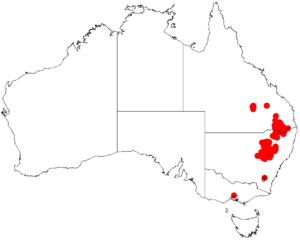Western silver wattle facts for kids
Quick facts for kids Western silver wattle |
|
|---|---|
| Scientific classification | |
| Genus: |
Acacia
|
| Species: |
polybotrya
|
 |
|
| Occurrence data from AVH | |
The Acacia polybotrya, also known as the western silver wattle or the hairy feather wattle, is a type of shrub. It belongs to the Acacia plant family. This plant grows naturally in parts of New South Wales and Queensland, Australia.
Contents
About the Western Silver Wattle
This spreading shrub usually grows to be about 1 to 5 meters (3 to 16 feet) tall. It often has many stems and a flat top. The bark is smooth and can be greenish or gray. Its branches are smooth or have only a few hairs.
The leaves are blue-green and feel a bit like leather. They are long and thin. Each leaf has a main stem, called a rachis, which is about 0.5 to 3 centimeters long. From this stem, two to four pairs of smaller leaf parts, called pinnae, branch off. Each pinna is 1 to 4.5 centimeters long.
On these pinnae, there are 4 to 12 pairs of even smaller leaf parts called pinnules. These pinnules are shaped like a spearhead or an oval. They are about 4 to 10 millimeters long and 1.5 to 3 millimeters wide.
Flowers and Seed Pods
The western silver wattle blooms from August to November. It produces bright yellow flowers. These flowers grow in groups of 3 to 25. They form a cluster called a panicle or grow along a stem called an axillary raceme. This stem can be 1 to 8 centimeters long.
Each flower-head is round and about 4 to 7 millimeters across. It contains 20 to 35 bright yellow flowers. After the plant flowers, thin, leathery seed pods start to grow. These pods can be straight or curved, and they are often twisted.
The pods are squeezed in between each seed. They are about 4 to 11.5 centimeters long and 4 to 8 millimeters wide. The pods are covered in a white, powdery layer.
How it Was Named
The western silver wattle was first officially described by a botanist named George Bentham. He wrote about it in 1842. This description was part of a larger work by William Jackson Hooker.
Later, in 1987, another botanist named Leslie Pedley reclassified it. He gave it the name Racosperma polybotryum. However, in 2001, it was moved back to the Acacia family. So, its main name is Acacia polybotrya again.
It also has a couple of other names that are no longer used. These are called synonyms. They include Acacia polybotrya var. typica and Acacia polybotrya var. polybotrya.
Where the Western Silver Wattle Grows
This plant is found only in certain areas. It grows in southeastern Queensland, especially in the southern part of the Darling Downs district. Its range extends south into the central western slopes and northwestern plains of New South Wales. It can be found as far south as the Munghorn Gap Nature Reserve.
The western silver wattle grows in different types of places. It likes rocky, sandy, or gravelly clay soils that are not very fertile. You can find it in open Eucalyptus woodlands or in shrubland communities.

